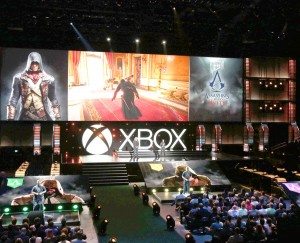Publishers play it safe at Electronic Entertainment Expo
The Electronic Entertainment Expo started this week off with a bang as every gamer waited anxiously for the next generation of games from the video game industry’s foremost developers and publishers. From Microsoft to Sony, each company had big name titles and gameplay to showcase. Whether these games were still in development or newly announced, playable demos and videos were released to international scrutiny.

Unified at last · Xbox E3 briefing included a live demonstration of the next installment in Ubisoft’s Assasin’s Creed franchise, Unity. The next-generation game experience will feature collaborative multiplayer gameplay. – Photo Courtesy of Xbox Wire
This year’s E3 gave gamers around the world a sneak peek at the next generation of gaming, which mainly emphasized integrated, worldwide and real-time multiplayer capabilities. With bated breath, drumming fingers and sweaty palms, gamers and developers around the world patiently waited for the biggest question to be answered: what’s next?
Traditionally, companies such as Ubisoft, Electronic Arts, Nintendo, Sony and Microsoft hold a press briefing the day before the opening of E3’s show floor. Similarly to last year, Nintendo stepped down from holding a live press conference alongside its fellow competitors. Instead, ihe company chose to show a pre-rendered video on the opening day of E3.
After the company’s abysmal sales of the Nintendo WiiU, it is unclear if Nintendo will host a live press conference at the convention in future years. Meanwhile, the other companies broadcasted live demonstrations of real-time game play along with well-prepared video trailers.
Near the end of May, game titles and release date leaks rattled the online community. Leaked information spoiled the pre-E3 energy as the audience swelled with worry rather than excitement. While the speakers introduced the upcoming lineup of games, audience members eagerly anticipated a surprise announcement or breaking news. Even a small technical mistake would have aroused more interest in E3’s drawn-out television advertisements and seemingly never-ending hype.
The live demonstrations certainly lived up to the hype, giving viewers a chance to jump into the world of Assassin’s Creed: Unity, Far Cry 4 and Battlefield: Hardline. During EA, Ubisoft, Microsoft and Sony’s press conferences, they demonstrated that the future of gaming is not in grotesque graphics or new shiny weaponry, but in unity. The recent pattern of online co-op games and live-streaming gave rise to the immense popularity of multiplayer games.
Both Microsoft and Ubisoft’s demonstrations of Assassin’s Creed: Unity multiplayer capabilities retained the original concept of the first game. However, the inclusion of four new multi-colored, caped and stubbled male characters left much to be desired. Other than Captain Xavier’s impressive aerial assassination, the gameplay remained stale and repetitive. Using the same tactics as its predecessors, Arno Dorian stealthily moves around Paris on the eve of the French Revolution, and does what he does best: killing enemies from behind. In Unity, Dorian gains three new companions on his journey to expose the true corruption behind the Revolution.
Another notable title was Battlefield: Hardline’s beta demo at EA’s press briefing. Hardline opens in a fictional rendition of downtown Los Angeles as a bank heist that places two teams against each other. A game of eight players engage in a strategic reinvention of a cross between “Capture the Flag” and “Cops and Robbers,” in which four players play the thieves who try to drop off their “loot,” while the other four play as the police who try to stop the thieves from escaping. As a first-person shooter, the game looks impressive with its interesting escape tactics, some of which involve grappling hooks and falling construction cranes. But the gameplay itself seemed too similar to other FPS games such as Tom Clancy’s The Division, in which the player can only hide behind cars for protection and shoot a limited number of bullets to take out the enemy.
Despite the potential for both philosophical and social breakthroughs in the gaming community, this year was not the year of women. Female-led games such as Rise of the Tomb Raider and Mirror’s Edge 2 lost steam in light of the domination of seemingly identical first-person shooters.
One aspect of all the press conferences was surprising: most publishers refused to take risks. This year’s E3 gave gamers around the world a sneak place of the next generation of gaming, which places much more emphasis on expanding the multiplayer capabilities within existing game franchises. Since the Xbox One and Playstation 4 were released last year, E3 2014 opened the door for publishers and developers to showcase software with more impressive graphics and bigger content, and also expanded the possibilities of next-generation gaming.
Instead of including new and unannounced material, all of the big companies decided to play it safe by broadcasting pre-rendered videos of software in development as opposed to offering playable demos, as well as showing off titles that already had leaked dates.
In addition to “playing it safe,” publishers were reluctant to release playable demos for some highly anticipated franchises. High-profile games such as Mirror’s Edge 2, Mass Effect 4 and Dragon Age Inquisition had little to show after one long year of hard work. Though fans might have expected actual playable demonstrations of these games, they were left with game developer diaries and “inside looks.”
However, gamers at home no longer have to feel left out from the tightly closed-off trade show. Since the show is only available to a closed number of qualified computer and gaming audiences, E3 gave fans around the world the ability to beta test from their own homes immediately after the press conferences. Even though there were plenty of missteps this year, publishers showcasing at E3 demonstrated their understanding of the rapidly expanding international community of gamers by making its games readily available to the gaming community.

